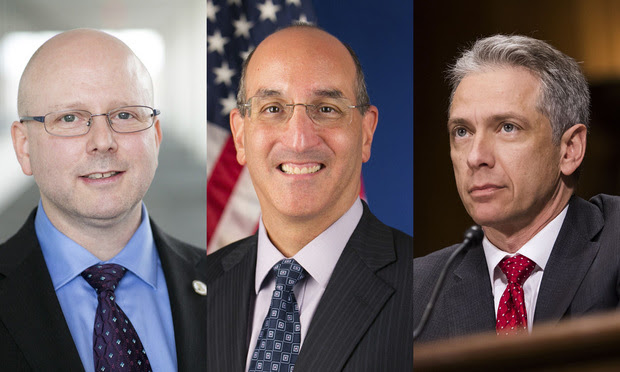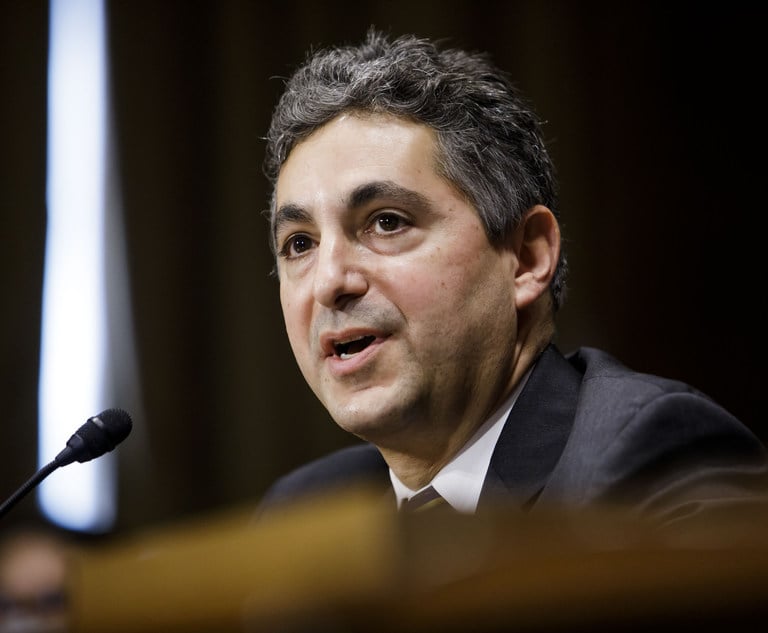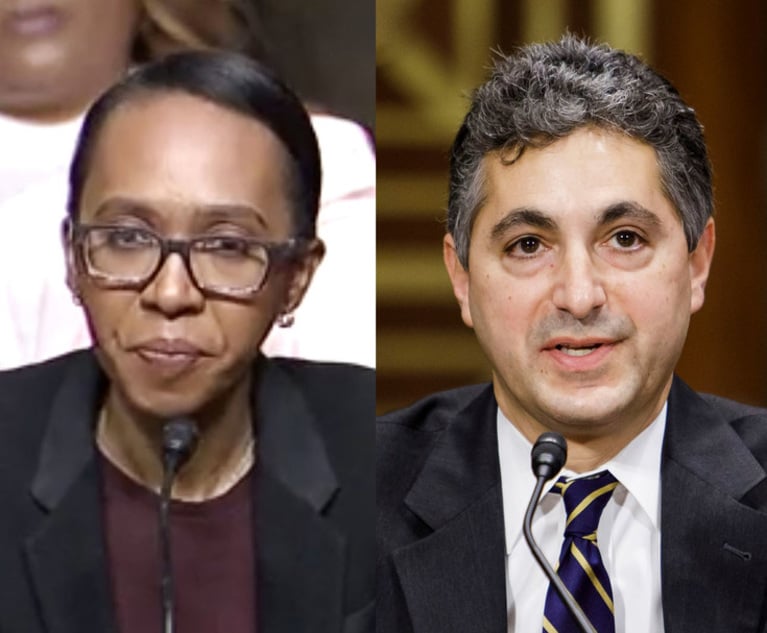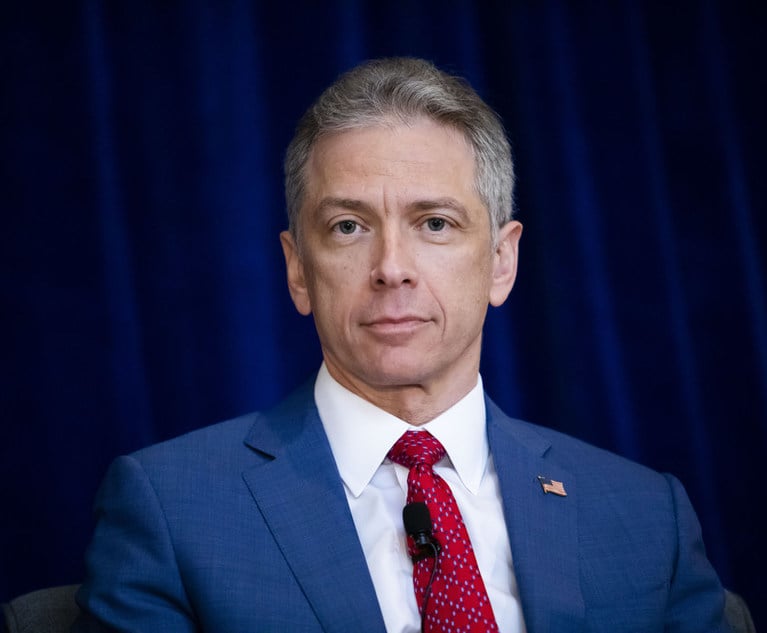Skilled in the Art: Pop Goes the PTAB + Supreme Court Sure Seems Curious About Section 101
Eliot Williams of Baker Botts has some takeaways from the first pronouncement to come out of the PTAB's POP panel.
March 19, 2019 at 12:00 PM
9 minute read
Welcome to Skilled in the Art. I'm Law.com IP reporter Scott Graham. Today I've got analysis of the Patent Trial and Appeal Board's first POP decision (that's Precedential Opinion Panel for you non-PTAB wonks). Plus, the U.S. Supreme Court keeps making noise about revisiting Section 101, and Wilson Sonsini has snagged a Stanford University licensing legend. As always you can email me your thoughts and follow me on Twitter.
 Left to right, PTAB Chief Judge Scott Boalick, Commissioner of Patents Drew Hirshfeld and PTO Director Andrei Iancu
Left to right, PTAB Chief Judge Scott Boalick, Commissioner of Patents Drew Hirshfeld and PTO Director Andrei Iancu
OP Goes the PTAB
The PTAB's POP panel has issued its first pronouncement.
The board created a Precedential Opinion Panel last fall comprising PTO Director Andrei Iancu, Commissioner of Patents Drew Hirshfeld and PTAB Chief Judge Scott Boalick. They or their designees will rehear issues that raise policy concerns and/or are deemed exceptionally important. It was billed as a more upfront and transparent version of the stacked panels that the PTAB was criticized for using under previous leadership.
The POP convened for the first time Jan. 31. Iancu was hardly a potted plant: He posed some 35 questions to Mark Garrett of Norton Rose Fulbright and Gianni Cutri of Kirkland & Ellis over the 40-minute hearing. (Garrett noted at the outset that he'd ridden up the elevator with another PTAB judge, “as if I needed another reason to be nervous today.”)
The issue was whether an inter partes review petitioner can get around the one-year time bar by filing a new petition after a proceeding has been instituted and joining the new petition with the old one. The panel ruled that … it depends. The board may exercise its discretion to permit such a maneuver, but “only in limited circumstances—namely, where fairness requires it and to avoid undue prejudice to a party,” Boalick wrote for the panel in Proppant Express Investment v. Oren Technologies.
If a patent owner were to add new claims to its district court litigation, that might justify a petitioner filing a new PTAB petition and joining it, Boalick explained. “On the other hand, the board does not generally expect fairness and prejudice concerns to be implicated by, for example, a petitioner's mistakes or omissions,” he wrote.
The upshot is that Garrett and Proppant are out of luck, and that patent owner Oren and Cutri won't have to face the new petition.
For a view beyond this case, I called on veteran PTAB litigator Eliot Williams of Baker Botts for some takeaways.
➤ So far, Iancu is making good on his promise of balance. “I would say there's a little something for everybody in this first decision,” Williams said. “It could have taken a path that was very anti-petitioner. I think it's notable that it's in the middle here. In other words, it doesn't look like this is going to be an entirely patent-owner-heavy-focused PTAB under the new management.” At least, not based on this first opinion.
➤ The POP isn't trying to have the last word. “As a Precedential Opinion Panel decision, it doesn't give a tremendous amount of guidance to future panels on when to exercise this discretion [to allow joinder], other than to make clear it should not be used frequently and not for what they call petitioner's errors. … It does leave the door open for some additional development by future panels to try to determine what other fact scenarios might be sufficient,” Williams said.
➤ Yes, there is a practice pointer here. “It does somewhat change the risk profile of putting a petition together where there's some uncertainty about what claims might ultimately be asserted in the litigation,” Williams said. For example, after filing in district court, a patent owner might sometimes assert new claims in a parallel U.S. International Trade Commission complaint. “It maybe gives you a little more certainty as a petitioner to pick the claims that have been asserted in the complaint or maybe in an early set of infringement contentions, now kind of feeling that you've got this second chance.”
High Court Has More Questions on Section 101
It sounds as if the Section 101 natives are getting restless at the Supreme Court. For the second time this year, the justices on Monday asked for the solicitor general's views on a patent eligibility case.
A couple of years ago, the conventional wisdom was that, having wrestled Section 101 to the ground with its Bilski, Mayo, Myriad and Alice decisions, the Supreme Court was taking a permanent hiatus from the subject.
But that was before Neil Gorsuch and Brett Kavanaugh joined the court (and Gorsuch began bringing in patent-savvy clerks like Notre Dame professor Stephen Yelderman). In January, the court asked for the SG's views on HP v. Berkheimer. That's the case in which the Federal Circuit ruled that, sometimes, determining eligibility requires fact finding.
On Monday, the court asked the SG to weigh in on Hikma Pharmaceuticals USA v. Vanda Pharmaceuticals. The issue is whether the application of a law of nature as a method of medical treatment—in this case adjusting the dosage of a potentially toxic medicine based on the patient's genotype—is eligible for a patent. The Federal Circuit said yes in a divided decision.
The bio-pharma industry has complained that Mayo in particular made it impossible to patent some genuine medical breakthroughs, such as an innovative method for determining fetal abnormalities. Sen. Chris Coons, who with Sen. Thom Tillis is promising to introduce Section 101 legislation this summer, pointed repeatedly at a hearing last week to the impact on the medical diagnostics industry.
Vanda and its Paul Weiss Rifkind Wharton & Garrison attorneys say that “what is really at stake here” is the generic drug industry's desire to get all method-of-treatment patents ruled ineligible under Section 101. Conversely, Hikma and Winston & Strawnsay that if the Federal Circuit's decision stands, any method-of-treatment claim will “automatically satisfy Section 101.”
“I think two CVSGs suggests that the court is concerned about the way the doctrine is developing at the Federal Circuit and the broader impact that Mayo and Alice have had,” Emory professor Tim Holbrook said. “The petitions are also framed in ways that are attractive to the court—Berkheimer with the fact/law divide and [Hikma] with bright line rules at the Federal Circuit (even if that characterization is not necessarily accurate).”
Villanova law professor Michael Risch also noted the theme of hard-and-fast rules versus more general standards. “The Federal Circuit likes rules,” he said. “Berkheimeris about whether judgments are correct on the pleadings, and the 'rule' seems to be you need evidence. Vanda is about whether a new treatment method is eligible. The Federal Circuit doesn't mean always in either of these cases, but it's hard to distinguish when the rules of these cases don't apply.”
Risch also noted a practical matter. “Until the Supreme Court finally rules a patent eligible, we'll never really have peace in this area,” he said, “and so the court might be seeing if either of these two cases fit that bill.”
Wilson Hires Stanford Tech Transfer Legend
Wilson Sonsini Goodrick & Rosati has brought aboard a big fish in the licensing field. Katharine “Kathy” Ku, who spent 27 years as executive director of Stanford's technology licensing program, is joining the firm as chief licensing adviser in its Palo Alto office.
 Ku is known for having developed nine principles for university licensing—including structuring licenses to encourage technology development and use, and launching enforcement actions only after careful consideration—that have been adopted by more than 120 institutions.
Ku is known for having developed nine principles for university licensing—including structuring licenses to encourage technology development and use, and launching enforcement actions only after careful consideration—that have been adopted by more than 120 institutions.
“Kathy was involved in Stanford's transformation of research projects into some of the most important technologies in use today,” Wilson partner Ian Edvalson, who is co-leader of the firm's technology transactions practice, said in a written statement. “She has a level of insight into company formation and technology licensing matters that perfectly complements the expertise we offer to innovative companies and institutions.”
Ku began her Stanford career in 1979 as a patent engineer in the Office of Sponsored Research. She joined Stanford's Office of Technology Licensing in 1981, becoming executive director 10 years later. During her tenure, the office licensed hundreds of new technologies and brought in $1.8 billion, much of which went back to fund new research.
Ku retired from Stanford last June and had been working as an independent consultant.

Would Facial Recognition Be a Fair Use?
NBC reported last week that IBM is vacuuming up hundreds of thousands of images from Flickr to help train its facial recognition algorithms, without the consent of the photographers or their subjects.
My ALM colleague Victoria Hudgins explored some of the legal implications. One is whether such use would be considered “noncommercial” in order to bring it within Flickr's creative commons license. “The biggest challenge is what IBM is doing with creating this dataset is something definitely not contemplated by these photographers,” said Phoenix-based business and intellectual property attorney Sara Hawkins.
But even if the photographers have a copyright claim, IBM would have a decent fair use defense, said Dunlap Bennett & Ludwig partner David Ludwig. “IBM may come out and say, 'We are not copying the photos to sell them, we are using this to create an amazing AI tool.'”
IBM says its dataset is designed to help academic researchers make facial recognition technology fairer. According to NBC's report, facial recognition algorithms have struggled to correctly identify women and minorities.
That's all from Skilled in the Art today. I'll see you all again on Friday.
This content has been archived. It is available through our partners, LexisNexis® and Bloomberg Law.
To view this content, please continue to their sites.
Not a Lexis Subscriber?
Subscribe Now
Not a Bloomberg Law Subscriber?
Subscribe Now
NOT FOR REPRINT
© 2025 ALM Global, LLC, All Rights Reserved. Request academic re-use from www.copyright.com. All other uses, submit a request to [email protected]. For more information visit Asset & Logo Licensing.
You Might Like
View All
Skilled in the Art With Scott Graham: I'm So Glad We Had This Time Together

Design Patent Appeal Splinters Federal Circuit Panel + Susman Scores $163M Jury Verdict + Finnegan Protects Under Armour's House
Trending Stories
- 1Church of Scientology Set to Depose Phila. Attorney in Sexual Abuse Case
- 2An AG Just Specified How AI Could Get You in Hot Water
- 3Supreme Court Appears to Lean Toward Letting TikTok Ban Take Effect
- 4Standing Spat: Split 2nd Circuit Lets Challenge to Pfizer Diversity Program Proceed
- 5Judge Jablonski and Chief Justice Rabner Both Acted Completely Properly
Who Got The Work
Michael G. Bongiorno, Andrew Scott Dulberg and Elizabeth E. Driscoll from Wilmer Cutler Pickering Hale and Dorr have stepped in to represent Symbotic Inc., an A.I.-enabled technology platform that focuses on increasing supply chain efficiency, and other defendants in a pending shareholder derivative lawsuit. The case, filed Oct. 2 in Massachusetts District Court by the Brown Law Firm on behalf of Stephen Austen, accuses certain officers and directors of misleading investors in regard to Symbotic's potential for margin growth by failing to disclose that the company was not equipped to timely deploy its systems or manage expenses through project delays. The case, assigned to U.S. District Judge Nathaniel M. Gorton, is 1:24-cv-12522, Austen v. Cohen et al.
Who Got The Work
Edmund Polubinski and Marie Killmond of Davis Polk & Wardwell have entered appearances for data platform software development company MongoDB and other defendants in a pending shareholder derivative lawsuit. The action, filed Oct. 7 in New York Southern District Court by the Brown Law Firm, accuses the company's directors and/or officers of falsely expressing confidence in the company’s restructuring of its sales incentive plan and downplaying the severity of decreases in its upfront commitments. The case is 1:24-cv-07594, Roy v. Ittycheria et al.
Who Got The Work
Amy O. Bruchs and Kurt F. Ellison of Michael Best & Friedrich have entered appearances for Epic Systems Corp. in a pending employment discrimination lawsuit. The suit was filed Sept. 7 in Wisconsin Western District Court by Levine Eisberner LLC and Siri & Glimstad on behalf of a project manager who claims that he was wrongfully terminated after applying for a religious exemption to the defendant's COVID-19 vaccine mandate. The case, assigned to U.S. Magistrate Judge Anita Marie Boor, is 3:24-cv-00630, Secker, Nathan v. Epic Systems Corporation.
Who Got The Work
David X. Sullivan, Thomas J. Finn and Gregory A. Hall from McCarter & English have entered appearances for Sunrun Installation Services in a pending civil rights lawsuit. The complaint was filed Sept. 4 in Connecticut District Court by attorney Robert M. Berke on behalf of former employee George Edward Steins, who was arrested and charged with employing an unregistered home improvement salesperson. The complaint alleges that had Sunrun informed the Connecticut Department of Consumer Protection that the plaintiff's employment had ended in 2017 and that he no longer held Sunrun's home improvement contractor license, he would not have been hit with charges, which were dismissed in May 2024. The case, assigned to U.S. District Judge Jeffrey A. Meyer, is 3:24-cv-01423, Steins v. Sunrun, Inc. et al.
Who Got The Work
Greenberg Traurig shareholder Joshua L. Raskin has entered an appearance for boohoo.com UK Ltd. in a pending patent infringement lawsuit. The suit, filed Sept. 3 in Texas Eastern District Court by Rozier Hardt McDonough on behalf of Alto Dynamics, asserts five patents related to an online shopping platform. The case, assigned to U.S. District Judge Rodney Gilstrap, is 2:24-cv-00719, Alto Dynamics, LLC v. boohoo.com UK Limited.
Featured Firms
Law Offices of Gary Martin Hays & Associates, P.C.
(470) 294-1674
Law Offices of Mark E. Salomone
(857) 444-6468
Smith & Hassler
(713) 739-1250










